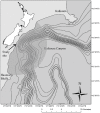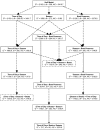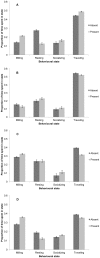Behavioural responses of dusky dolphin groups (Lagenorhynchus obscurus) to tour vessels off Kaikoura, New Zealand
- PMID: 22844536
- PMCID: PMC3402466
- DOI: 10.1371/journal.pone.0041969
Behavioural responses of dusky dolphin groups (Lagenorhynchus obscurus) to tour vessels off Kaikoura, New Zealand
Abstract
Background: Commercial viewing and swimming with dusky dolphins (Lagenorhynchus obscurus) near Kaikoura, New Zealand began in the late 1980s and researchers have previously described changes in vocalisation, aerial behaviour, and group spacing in the presence of vessels. This study was conducted to assess the current effects that tourism has on the activity budget of dusky dolphins to provide wildlife managers with information for current decision-making and facilitate development of quantitative criteria for management of this industry in the future.
Methodology/principal findings: First-order time discrete Markov chain models were used to assess changes in the behavioural state of dusky dolphin pods targeted by tour vessels. Log-linear analysis was conducted on behavioural state transitions to determine whether the likelihood of dolphins moving from one behavioural state to another changed based on natural and anthropogenic factors. The best-fitting model determined by Akaike Information Criteria values included season, time of day, and vessel presence within 300 m. Interactions with vessels reduced the proportion of time dolphins spent resting in spring and summer and increased time spent milling in all seasons except autumn. Dolphins spent more time socialising in spring and summer, when conception occurs and calves are born, and the proportion of time spent resting was highest in summer. Resting decreased and traveling increased in the afternoon.
Conclusions/significance: Responses to tour vessel traffic are similar to those described for dusky dolphins elsewhere. Disturbance linked to vessels may interrupt social interactions, carry energetic costs, or otherwise affect individual fitness. Research is needed to determine if increased milling is a result of acoustic masking of communication due to vessel noise, and to establish levels at which changes to behavioural budgets of dusky dolphins are likely to cause long-term harm. Threshold values from these studies would allow managers to set appropriate operational conditions based on quantifiable criteria.
Conflict of interest statement
Figures




Similar articles
-
Behavioural effects of tourism on oceanic common dolphins, Delphinus sp., in New Zealand: the effects of Markov analysis variations and current tour operator compliance with regulations.PLoS One. 2015 Jan 7;10(1):e0116962. doi: 10.1371/journal.pone.0116962. eCollection 2015. PLoS One. 2015. PMID: 25565523 Free PMC article.
-
Assessment on the effectiveness of vessel-approach regulations to protect cetaceans in Australia: A review on behavioral impacts with case study on the threatened Burrunan dolphin (Tursiops australis).PLoS One. 2021 Jan 19;16(1):e0243353. doi: 10.1371/journal.pone.0243353. eCollection 2021. PLoS One. 2021. PMID: 33465088 Free PMC article. Review.
-
Effects of tour boats on dolphin activity examined with sensitivity analysis of Markov chains.Conserv Biol. 2012 Aug;26(4):708-16. doi: 10.1111/j.1523-1739.2012.01844.x. Epub 2012 May 24. Conserv Biol. 2012. PMID: 22624561
-
Echolocation signals of dusky dolphins (Lagenorhynchus obscurus) in Kaikoura, New Zealand.J Acoust Soc Am. 2004 May;115(5 Pt 1):2307-13. doi: 10.1121/1.1690082. J Acoust Soc Am. 2004. PMID: 15139642
-
Effects of vessels on common dolphin activity patterns in a critical area for the species. Conservation implications.Mar Environ Res. 2025 May;207:107081. doi: 10.1016/j.marenvres.2025.107081. Epub 2025 Mar 15. Mar Environ Res. 2025. PMID: 40120423 Review.
Cited by
-
Population ecology and the management of whale watching operations on a data-deficient dolphin population.Ecol Evol. 2019 Aug 22;9(18):10442-10456. doi: 10.1002/ece3.5565. eCollection 2019 Sep. Ecol Evol. 2019. PMID: 31624559 Free PMC article.
-
Behavioural effects of tourism on oceanic common dolphins, Delphinus sp., in New Zealand: the effects of Markov analysis variations and current tour operator compliance with regulations.PLoS One. 2015 Jan 7;10(1):e0116962. doi: 10.1371/journal.pone.0116962. eCollection 2015. PLoS One. 2015. PMID: 25565523 Free PMC article.
-
Behavioural responses of spinner dolphins to human interactions.R Soc Open Sci. 2018 Apr 25;5(4):172044. doi: 10.1098/rsos.172044. eCollection 2018 Apr. R Soc Open Sci. 2018. PMID: 29765660 Free PMC article.
-
Chronic exposure of Hawaii Island spinner dolphins (Stenella longirostris) to human activities.R Soc Open Sci. 2018 Oct 24;5(10):171506. doi: 10.1098/rsos.171506. eCollection 2018 Oct. R Soc Open Sci. 2018. PMID: 30473795 Free PMC article.
-
Assessment on the effectiveness of vessel-approach regulations to protect cetaceans in Australia: A review on behavioral impacts with case study on the threatened Burrunan dolphin (Tursiops australis).PLoS One. 2021 Jan 19;16(1):e0243353. doi: 10.1371/journal.pone.0243353. eCollection 2021. PLoS One. 2021. PMID: 33465088 Free PMC article. Review.
References
-
- O'Connor S, Campbell R, Cortez H, Knowles T. Whale Watching Worldwide: tourism numbers, expenditures and expanding economic benefit. Yarmouth: International Fund for Animal Welfare. 295 p. 2009.
-
- Cisneros-Montemayor AM, Sumaila UR, Kaschner K, Pauly D. The global potential for whale watching. Marine Policy. 2010;34:1273–1278.
-
- Constantine R. Increased avoidance of swimmers by wild bottlenose dolphins (Tursiops truncatus) due to long-term exposure to swim-with-dolphin tourism. Marine Mammal Science. 2001;17:689–702.
-
- International Whaling Commission (IWC) Report of the Scientific Committee. International Whaling Commission, Washington, D. 1996. C
-
- Hoyt E. A blueprint for dolphin and whale watching development. Washington, D.C.: Humane Society International. 29 p. 2007.
Publication types
MeSH terms
LinkOut - more resources
Full Text Sources

